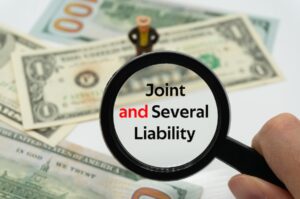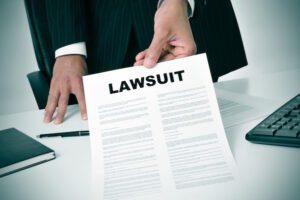In certain types of Nevada personal injury cases where more than one party injured you, you do not have to sue all of them to recover your damages. Under the state’s joint and several liability laws, you only have to sue one of them to recover 100% of your damages.
This way, you can get a full payout without having to deal with multiple defendants. The defendant who overpaid you can then sue the other at-fault parties for reimbursement.
To help you better understand joint and several liability, our Nevada personal injury lawyers discuss the following, below:
- 1. When does joint and several liability apply?
- 2. How it Works
- 3. No Double Recoveries
- 4. How is comparative negligence different?
- 5. Combination Cases
- Additional Reading
1. When does joint and several liability apply?
In Nevada, joint and several liability does not apply in most personal injury cases. Under NRS 41.141(5), defendants are jointly and severally liable in lawsuits based on only one of these five circumstances:
- Strict liability;
- An intentional tort (such as assault or battery);
- The emission, disposal or spillage of a toxic or hazardous substance;
- The concerted acts of the defendants (which does not include negligent healthcare providers working together to treat you); or
- An injury to any person or property resulting from a dangerous product which is manufactured, distributed, sold or used in this State.1
In short, joint and several liability typically applies to cases involving intentional acts or strict liability.

Joint and several liability makes it easier for victims to recover for their losses.
2. How it Works
Example: Paul recruits his friend Quentin to help him beat up a troublesome neighbor, who sustains $10,000 in medical bills. Because Paul and Quentin commit the assault together (“a concerted act of the defendants”), joint and several liability applies. This means the neighbor can sue either Paul or Quentin for the full $10,000.
Example: Max is burned by a defective microwave he bought at Target and was manufactured by Panasonic. Since this case involves a defective product, joint and several liability applies. This means Max can sue either Target or Panasonic for 100% of his damages.
Joint and several liability is especially beneficial in cases where one of the at-fault parties is:
- insolvent,
- in other state, or
- otherwise judgment-proof.
As long as one of the other at-fault parties has enough money, you can sue them for everything even though they are only partly to blame.
3. No Double Recoveries
Joint and several liability does not allow you to recover more than 100% of your damages by suing more than one wrongdoer.
Therefore, if you recover 100% of your damages in a lawsuit or settlement from one defendant, you cannot go after the other at-fault parties even though they also harmed you.
Example: Alex and Ben are equally responsible for burning Cathy’s car. Joint and several liability applies because it is a “concerted act of the defendants.” Cathy sues Alex, who pays her the full value of her car. Afterwards, Alex can sue Ben for half the value (Ben’s “contribution”). Whether Ben pays Alex or not has no effect of Cathy’s payout.
4. How is comparative negligence different?
In cases where joint and several liability does not apply, Nevada courts instead use “comparative negligence.” This is where all the at-fault parties are assigned a percentage of blame for harming you, and they are not responsible for paying you anything more than that percentage.2
Example: While at a gridlocked intersection, both Mike and James accidentally crash into Michelle, who sustains $20,000 in damages. At trial, the judge finds Mike and James each 50% responsible. Therefore, each owes Michelle $10,000. If Mike pays but James does not, Michelle cannot go after Mike for the rest.
So whereas joint and several liability generally applies to cases involving intentional wrongs and strict liability, comparative negligence – like its name implies – generally applies to negligence cases.
Negligence is when a person or company injures you by breaching their duty of care to you even if they had no intention of causing harm. Car accidents are among the most common negligence cases.
5. Combination Cases
Sometimes, one or more defendants act negligently while another acts intentionally. The Nevada Supreme Court considered this situation in a 2012 case Cafe Moda v. Palma.3
In that case, one restaurant patron stabbed another patron. The injured patron sued the assailant for an intentional act of assault and also sued the restaurant for negligently failing to prevent the attack. A jury determined that:
- the assailant was 80% responsible, and
- the restaurant was 20% responsible.
Since the restaurant only acted negligently, they were liable for just its 20% of the victim’s damages. Though since the assailant acted intentionally, he could be held liable for 100% of the victim’s damages under Nevada’s joint and several liability law.
Therefore, the patron could go after the assailant for 100% of the damages. If the assailant pays, the assailant could then try to get 20% of it back from the restaurant.

NRS 41.141(5) is Nevada’s joint and several liability statute.
Additional Reading
For more in-depth information, refer to these scholarly articles:
- Multidefendant Settlements: The Impact of Joint and Several Liability – The Journal of Legal Studies.
- The Logic and Fairness of Joint and Several Liability – Memphis State University Law Review.
- Settlements under Joint and Several Liability – NYU Law Review.
- Allocating Liability among Multiple Responsible Causes: A Principled Defense of Joint and Several Liability for Actual Harm and Risk Exposure – U.C. Davis Law Review.
- State Responsibility and the Principle of Joint and Several Liability – Yale Journal of International Law.

